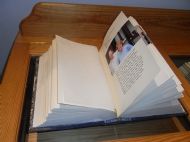history
The History of Newtonmore
Newtonmore itself does not have a long history. Before the early 1800s, the local population lived in townships in Glen Banchor, a mile or so to the West and about 200ft above the level of the present village. The building of the road bridge across the Spey in the 1760s encouraged a few people to build houses lower down, but the first mention of the village in Scottish Record Office papers (1823) refers to ‘Moor of Strone’ consisting of not more than 50 or 60 inhabitants.
The coming of the railway in the mid-1860s let to the village growing faster and the 1892 census shows a village with 364 inhabitants in 88 houses. Two more were under construction.
By 1929 the population was around 800 and the village was a busy tourist centre. The official guide, published by the CommunityCouncil, carried advertisements for 7 grocers, 2 butchers, 3 tailors, 2 boot & shoe makers, 1 boot repairer, 1 newsagent, e drapers and 2 garages. Many families let out their houses for the summer months and repaired to a small dwelling in their garden. 91 such houses are listed for let.
The advent of easier and more affordable foreign travel after the Second World War let to a fall in the number of visitors and the building of the new A9 trunk road in the 1970s, while relieving traffic congestion and noise, meant the loss of much passing trade.
Despite this and the ensuing loss of a bank, library, dairy, bread shop, chemist and family grocer, the village continues to thrive. The population has sttayed steady at around 1,000 for the last 30 years. The community is renowned for its fund-raising for good causes and willingness to help itself.
The Millennium book of Newtonmore


Newtonmore celebrated the Millennium with a torchlight procession, bonfire, fireworks and something more permanent. A hand-written and photographic record of everyday folk living in the village at the turn of a new century. The Millennium Book of Newtonmore.
The entries, written on vellum and beautifully bound in Scottish goat skin are held in three volumes which are kept in a specially built cabinet.
Every household in the village was invited to contribute something about themselves and to have a photograph taken. Around 75% agreed.
Teams of residents worked to collect the information and to take the photographs.
Newtonmore was the only village in the Highlands to create this type of record. As such, it not only holds intrinsic interest to the people of Newtonmore and their relatives, but has become a valuable, historic document providing a fascinating insight of life in a small Highland village in 1999.
Its uniqueness has earned it a place at The Am Fasgadh building, which houses the main collection of the Highland Folk Museum. Unlike the museum, Am Fasgadh is open throughout the year. Anyone wishing to view the book can do so by arrangement with the museum telephone 01540673551 or e-mail highland.folk@highlifehighland.com. However, copies of the book are freely available for you to study at the Wildcat Centre, Main Street, Newtonmore PH20 1DD.
The name ‘Am Fasgadh’ is Gaelic for ‘the shelter’ – the perfect haven for The Millennium Book of Newtonmore.
Newtonmore Heritage Discussion Group
This group was set up on Facebook for people to add their reminiscences of Newtonmore in the past. Fascinating! Visit The Newtonmore Heritage Discussion Group Facebook page.